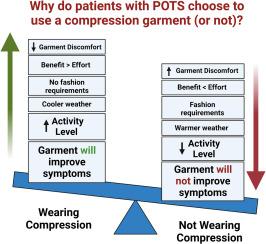One Size Does Not Fit All: An Exploration of Compression Garment Use in Patients With Postural Orthostatic Tachycardia Syndrome
IF 2.5
Q2 CARDIAC & CARDIOVASCULAR SYSTEMS
引用次数: 0
Abstract
Background
Postural orthostatic tachycardia syndrome (POTS) is a chronic form of orthostatic intolerance that primarily affects female patients. Despite the severity of POTS, there are no approved medications for use in patients with this disorder. Compression garments are a commonly prescribed nonpharmacological treatment, but little is known about the patient experience with compression. In this study we aimed to evaluate the patient experience with compression garments using a structured survey and semistructured telephone interviews.
Methods
A focused survey was designed as a component of a larger clinical trial on compression garment use in patients diagnosed with POTS. Building on the survey, semistructured telephone interviews were conducted with POTS patients. Recorded interviews were transcribed and coded in a thematic analysis using a descriptive-interpretive approach.
Results
A total of 27 participants completed the survey, and 20 participants completed the telephone interview. Patient experiences with compression were variable, with some participants experiencing significant benefits, and others reporting minimal to no benefits. Six themes that influenced garment use were identified: the potential benefit of the garment to improve symptoms, specific activities patients will be undertaking, environmental conditions, garment attributes, psychological and cognitive aspects, and financial considerations.
Conclusions
Participants engage in a daily cost-benefit analysis when making decisions to use a compression garment. Clinicians should be aware of the benefits of and factors that limit use of compression garments as a treatment for POTS.

尺码并不适合所有人:对体位性正位性心动过速综合征患者使用压力衣的探讨
背景体位性正位性心动过速综合征(POTS)是一种慢性正位性不耐受,主要影响女性患者。尽管 POTS 很严重,但目前还没有获准用于该疾病患者的药物。压力衣是一种常用的非药物治疗方法,但人们对患者的压力体验知之甚少。在这项研究中,我们旨在通过结构化调查和半结构化电话访谈来评估患者对压力衣的使用体验。方法我们设计了一项重点调查,作为对确诊为 POTS 患者使用压力衣的大型临床试验的一个组成部分。在调查的基础上,对 POTS 患者进行了半结构化电话访谈。结果共有 27 名参与者完成了调查,20 名参与者完成了电话访谈。患者对压力疗法的体验各不相同,一些参与者体验到了明显的益处,而另一些参与者则表示益处很小甚至没有益处。调查确定了影响压力衣使用的六个主题:压力衣对改善症状的潜在益处、患者将要进行的特定活动、环境条件、压力衣属性、心理和认知方面以及经济因素。临床医生应了解使用压力衣治疗 POTS 的益处和限制因素。
本文章由计算机程序翻译,如有差异,请以英文原文为准。
求助全文
约1分钟内获得全文
求助全文
来源期刊

CJC Open
Medicine-Cardiology and Cardiovascular Medicine
CiteScore
3.30
自引率
0.00%
发文量
143
审稿时长
60 days
 求助内容:
求助内容: 应助结果提醒方式:
应助结果提醒方式:


